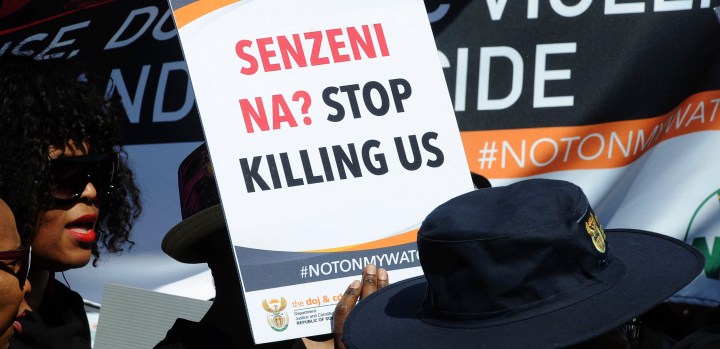BHEKISISA OP-ED
Madness in the method: Why government’s GBV ‘hot spots’ are really ‘not spots’

The police recently announced 30 gender-based violence hot spots to which extra resources will be directed to address violence against women. But the methods they used to identify these areas are flawed - and they might be elsewhere.
Police Minister Bheki Cele’s September announcement that the police had “pinned down” 30 areas recording the highest levels of gender-based violence (GBV) in the country generated interest and hope.
“Might the targeted policing of GBV finally yield some success in the country’s attempts to address the problem?” South Africa wondered.
Unfortunately, because of the methods the police used to identify these hot spots of violence, the answer, at best, is a lukewarm “maybe”.
Questions of method are not academic abstractions, they have real-world consequences.
In this case, the 30 hot spots will receive extra resources and services, such as permanent desks dedicated to attend to GBV cases, DNA evidence collection kits and shelters. These areas will also benefit from campaigns and strategies to raise awareness of gendered forms of violence and abuse.
If we go by the 30 hot spots the police have identified, these resources will be distributed to nine in Gauteng, eight in the Western Cape, seven in KwaZulu-Natal, three in the Eastern Cape, two in the Free State and one in North West.
Limpopo, Mpumalanga and the Northern Cape will receive none of this government largesse because they don’t contain a single hot spot.
A messy exercise: finding SA’s ‘Top 30’ police stations
A minister’s speaker note is, of course, not a research document, but Cele’s 22 September speech is the only document in the public domain that provides some insight into how the hot spots were identified.
It does, at least, outline the sources of information from which these areas were compiled. One source is the police’s crime statistics between 1 April 2019 and 31 March 2020. The specific crimes focused on are rape; kidnapping with the purposes of committing a sexual offence; trafficking, especially for purposes of sexual exploitation; murder and attempted murder within the context of domestic violence and cases of assault with intent to cause grievous bodily harm.
It is possible to compare the 30 hot spots announced in September with the various lists of “top 30 stations” identified by the crime statistics, because the police have listed the 30 stations recording the highest number of reports for the selected crime categories for several years. But this is a messy exercise because the police are inconsistent with the type of details they record.
In 2019/20, for instance, the police provided no statistics on trafficking. Neither did they disaggregate the statistics of their top 30 stations lists — for murder, attempted murder and assault with the intent to cause grievous bodily harm — by gender. So it’s not possible to speculate how many of these crimes occurred within the context of a domestic relationship. There is also no breakdown of the number of kidnappings occurring in the context of sexual offences.
Police stations that report the most rape missing from ‘hot spots’
Ultimately, it is rape that offers the least confusing comparison between lists.
Because the 30 hot-spot stations are being prioritised for DNA evidence collection kits, it is particularly important that they match the top 30 stations for rape — DNA evidence is crucial to solving and prosecuting cases of stranger and serial rape (meaning that all stations should, by right, be receiving such kits).
And yet eight of the top 30 stations for rape are not included among the 30 hot spots. Three of these stations are in Limpopo, which has no GBV hot spots, according to the police.
Given that it recorded the fifth-highest number of reports of rape in 2019/20, the exclusion of Thohoyandou is especially surprising. Lusikisiki in the Eastern Cape is another notable omission, as it features in the top 30 stations for rape and murder.
It is also not obvious why Kopanong in the Free State, Butterworth in the Eastern Cape and Bellville in the Western Cape were included among the hot spots — none features on any of the relevant top 30 station lists.
What about those left uncounted?
Much GBV data is skewed by the fact that many survivors of rape and domestic violence do not report the violence done to them to the police. The most recent data on under-reporting — now a decade old and drawn from a community-based survey conducted in Gauteng — found that although about a quarter (25.3%) of the women interviewed had experienced sexual violence in their lifetimes, only one in 25 had reported the rape to the police.
Between April 2008 and March 2009, 12,093 women in Gauteng, or 0.3% of the province’s adult female population, reported an assault by an intimate partner to the police. By contrast, during the same period, 18.1% of women in the province reported an experience of violence at the hands of intimate male partners to researchers.
The police seem to have tried to take under-reporting into account by also deriving their information from the Thuthuzela Care Centres (one-stop centres where rape can be reported and medical and psychological services can be accessed), health facilities, “calls related to domestic violence and gender-based violence” (probably referring to calls made to the Gender-Based Violence Command Centre), and “other data from other departments”, a phrase so vague as to be meaningless.
The Thuthuzela Care Centres (TCCs) may be a useful source of data, the others less so. According to the National Prosecuting Authority’s 2017/18 Annual Report, 33,973 sexual offences were attended to by the TCCs during those 12 months. However, in 35% of adult cases, the victim did not wish to pursue a criminal charge and wanted TCC health and counselling services only. The TCCs are therefore a potential source of information about under-reporting. However, subsequent annual reports have not made this information publicly available so it is not known whether such calculations were available to the police.
The Gender-Based Violence Command Centre is a considerably less helpful source of information because, while it may receive many calls, only a fraction relate to GBV. In 2017/18 the command centre received 182,354 calls, of which 1,047 were reported as GBV cases, while of the 102,286 calls in 2018/19, just 2,257 were GBV-related, according to the Department of Justice and Constitutional Development’s 2018/19 annual report.
Disorganised data hides the need for help in rural provinces
It is not only messy data, compiled on the basis of unexplained reasoning, that raises questions about how the hot spots were identified; it is also the failure to control for population size. Not doing so utterly disadvantages the Northern Cape and its small population.
Systems of ranking informed only by the total number of cases reported are going to produce lists with a predominance of stations serving densely populated areas. To correct for this it is necessary to look at the number of crimes relative to the size of the population.
For example, 150 rapes were reported over a year at station A, while 400 rapes were reported at station B. Station B may look as if it has the bigger problem until one takes into account that station A serves a population of 2,000 and station B 20,000. This means 8% of the population reported being raped at station A, while the proportion reporting rape at station B was 2%. Station A is therefore the hot spot even though the total number of rapes is lower than station B’s.
Not having adjusted station figures for population size may help explain why 24 of the 30 hot spots are found in the three most populous provinces and none in the least populated province.
Identifying where women are at particular risk of GBV, and taking action accordingly, can make a tremendous contribution to addressing violence. But you need to be sure you’ve pinpointed the right spots. Whether the police have identified such hot spots of violence is open to debate. DM/MC
Lisa Vetten is a research and project consultant in the faculty of humanities at the University of Johannesburg where she works on the “Gendered Violence and Urban Transformation in India and South Africa” study.
This story was produced by the Bhekisisa Centre for Health Journalism. Sign up for the newsletter.




















 Become an Insider
Become an Insider
Comments - Please login in order to comment.